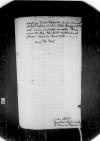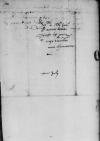Libellus Reverendissimae Dominationis Vestrae, quem ego doctis et bonis viris probatum iri confido, excusus iam est. Prima charta non prius imprimetur, quam fuerit aliquid de episcopatibus istis constitutum. In horas autem designatum iri quempiam Posnaniensem arbitramur, ita quod mora longa futura non est. Rumor est varius. Sunt, qui ⌊Praemisliensem episcopum⌋ ad eam sedem translatum iri putant. Quod quidem optarim, ut in locum eius succederet ⌊dominus vicecancellarius⌋. Alii ⌊Luceoriensem⌋, alii praepositum ⌊Laski⌋, alii ⌊Sbanski⌋, alii ⌊Vielamowski⌋ Posnaniensem fore asserunt. Sed et ⌊Chelmensis episcopus⌋ bene sibi pollicetur. Cor ⌊regis⌋ in manu Dei: emerget tandem aliquando aliquis.
Nova haec sunt. Rediit ⌊nuntius⌋ a ⌊caesare Turcarum⌋, pacem nobis et amicitiam attulit tantam, ut ad ipsos etiam ⌊Tartaros⌋ miserit tyrannus ille Turcarum, ne quid
s(erenissimae) or s(acrae)⌈s(erenissimae)s(erenissimae) or s(acrae)⌉
⌊maiestatis regiae⌋ ditionibus negotii exhiberent. Qui[1] quidem et ipse venturus huc exspectatur; brevi quid ab eo perfectum sit, cognoscemus. Sed qui  BCz 1618, p. 338 se nobis amicum esse profitetur, ⌊Turcarum tyrannus,⌋ is non obscure fert animo se esse alieno a serenissimo domino ⌊Hungariae rege⌋, alieniore procul dubio futurus, cum de nece legati sui factus erit certior. Is enim paucis comitatus ad ⌊regem Hungariae⌋ missus, benigne ab eo acceptus, perfecta legatione dimissus est liberaliter. Qui vero ex cohorte regia adiunctus ei erat, ut curam eius gereret, neve rei alicuius penuriam pateretur, provideret, is cum eum discedentem esset comitatus, tertio a ⌊Buda⌋ lapide interfecit hominem atque aliquot eius comites spe pecuniae cuiusdam potiundae, quae fuerat Budae relicta. ⌊Rex⌋ re cognita misit, qui eum persequerentur; sed cum in ditionem ⌊Romanorum regis⌋ aufugisset, loci illius praefectus persequi eos ulterius non permisit hidden by binding⌈[t]t hidden by binding⌉. Verendum est, ne haec res ingentes turbas excitet. De intercepto per ⌊Turcas⌋ nobilissimo emporio ⌊regis Portugaliae⌋ puto Reverendissimam Dominationem Vestram certiora istic habere. Hic adhuc rumor est, sed non omnino certus, deletum esse exercitum per ⌊Sophi Persarum regem⌋. C hidden by binding⌈[C]C hidden by binding⌉elantur haec
BCz 1618, p. 338 se nobis amicum esse profitetur, ⌊Turcarum tyrannus,⌋ is non obscure fert animo se esse alieno a serenissimo domino ⌊Hungariae rege⌋, alieniore procul dubio futurus, cum de nece legati sui factus erit certior. Is enim paucis comitatus ad ⌊regem Hungariae⌋ missus, benigne ab eo acceptus, perfecta legatione dimissus est liberaliter. Qui vero ex cohorte regia adiunctus ei erat, ut curam eius gereret, neve rei alicuius penuriam pateretur, provideret, is cum eum discedentem esset comitatus, tertio a ⌊Buda⌋ lapide interfecit hominem atque aliquot eius comites spe pecuniae cuiusdam potiundae, quae fuerat Budae relicta. ⌊Rex⌋ re cognita misit, qui eum persequerentur; sed cum in ditionem ⌊Romanorum regis⌋ aufugisset, loci illius praefectus persequi eos ulterius non permisit hidden by binding⌈[t]t hidden by binding⌉. Verendum est, ne haec res ingentes turbas excitet. De intercepto per ⌊Turcas⌋ nobilissimo emporio ⌊regis Portugaliae⌋ puto Reverendissimam Dominationem Vestram certiora istic habere. Hic adhuc rumor est, sed non omnino certus, deletum esse exercitum per ⌊Sophi Persarum regem⌋. C hidden by binding⌈[C]C hidden by binding⌉elantur haec  BCz 1618, p. 339 fortasse per ⌊Turcas⌋ diligenter, ne qua permanent ad nos.
BCz 1618, p. 339 fortasse per ⌊Turcas⌋ diligenter, ne qua permanent ad nos.
Cetera, si potero, scribam deinceps Reverendissimae Dominationi Vestrae. Cuius me gratiae commendo. Deum precor, ut illam diu servet incolumem et felicem.
 BCz 1618, p. 338 se nobis amicum esse profitetur,
BCz 1618, p. 338 se nobis amicum esse profitetur,  BCz 1618, p. 339 fortasse per
BCz 1618, p. 339 fortasse per 


